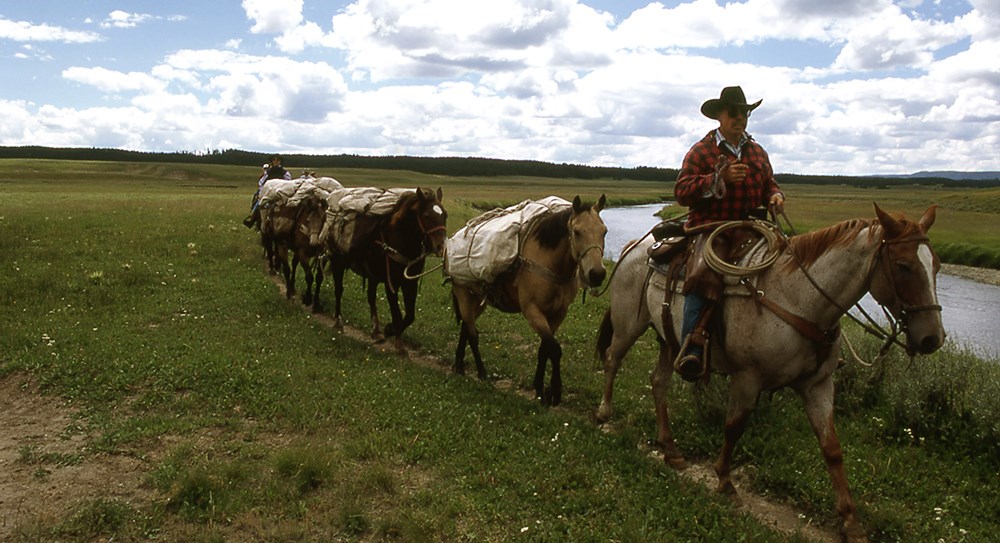
NPS / Jim Peaco Traveling in the Yellowstone backcountry with horses, mules, or llamas is an exciting way to see the park. By their very nature, these large animals have the potential to leave great impacts on the land around them. To assist you in planning a safe, enjoyable, and low-impact trip, rangers have developed the following regulations:
Hay and straw harvested from weed-infested areas and, vehicles, trailers, and equipment used or stored in areas infested with weeds can trap noxious plant seeds. If not detected, they can promote weed invasion in Yellowstone. Please read Exotic Plants—Don't Let Them Ride with You to help you make sure you don’t carry invasive plants into Yellowstone. At The TrailheadManure at the trailhead must be scattered or (preferably) removed. Keep stock off roadways, except at designated trail crossings. All feed must be processed to eliminate weeds and weed seeds. Securely wrapped, certified weed-free hay is allowed in the front-country but no hay is allowed in the backcountry. Trails Not Suitable For Stock On The TrailTrail travel must be single file on the established tread. This prevents braided trails and damage to surrounding areas. Short-cutting or cutting across switchbacks is prohibited. Stock groups may take day rides off-trail. Pack strings may not travel off-trail. Take only one pack animal to accompany the riding group to carry lunches, supplies, etc. It is strongly recommended that picket rope(s) or saddle hobbles be carried so that stock are not tied to trees. All pack stock must be led; loose herding or free-trailing is not allowed. In CampEach backcountry campsite has a limit on the number of people and stock allowed at the site. Reserve campsites in advance for overnight stock trips. Use only the fire ring already established in the campsite. Creating another fire ring is prohibited. Not all campsites allow for campfires. Extinguish your campfire thoroughly and, sift through the ashes for unburned food and trash, which must be packed out. Remove all foil, glass, etc. Keep in mind that whatever retention method you use (hobbles, pickets, electric fence, etc.), it must be set up and/or moved often enough to prevent damage to the resource. Select grazing areas carefully. Locate grazing sites at least 100 feet from streams, lake shores, trails, and camping areas. Avoid grazing in areas that have already been heavily grazed and, remember to rotate grazing areas often. Overgrazing weakens grasses, allows weeds to overtake native grasses, leaves nothing available for the next party, and ruins the beauty of the meadows. Keep your stock in the core camp only long enough to pack or unpack. A shorter time in camp means less impact and less manure that must be removed. Core camp is defined as that area within 100 feet of the fire ring or cooking area. Manure in the core camp must be completely removed, and manure in the grazing areas must be scattered (kicked). Scattered manure breaks down quicker and harbors fewer parasites. Subsequent users will find cleaner campsites and fewer flies. Watch where your stock graze so you’ll know where to look for the manure. Be prepared to spend extra time to locate and scatter manure throughout the entire grazing area, not just what you see on the way to and from your horses. We have no corrals in Yellowstone’s backcountry. No permanent improvements such as corrals, tables, or tent frames may be constructed. Tying stock to trees or constructed highlines for short periods (tacking and/or packing) is permissible, provided it does not damage the trees or the vegetation. Do not tie to a tree smaller than six inches in diameter. It is not a violation to tie a horse to a tree or highline; a violation is causing resource damage while the stock is retained. To avoid damage to trees, use tree saver straps or padding to protect trees. Some stock users prefabricate their low-impact highlines to make setup easier. Only dead and down wood may be used for picket pins and drag logs. Some users carry their own metal picket pins with them. Make sure your picket pins are pulled and not left in the meadow before you leave. Do not leave your stock unaccompanied in camp for long periods of time. Safety in Bear CountryProper food and garbage storage is essential to minimize the possibility of encounters with bears.
Learn more about traveling safely in bear country. 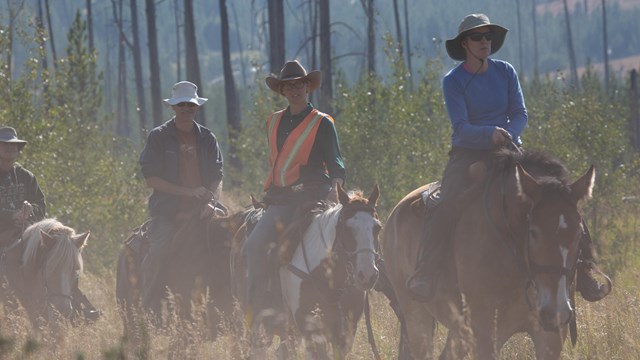
Day Ride Permits
Prior to riding in Yellowstone, you must obtain a free Day Ride Permit. 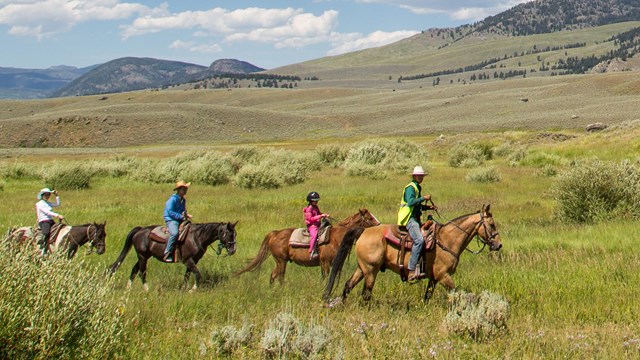
Exotic Plants: Don't Let Them Ride Along
Do your part to stop invasive plants from entering the park. 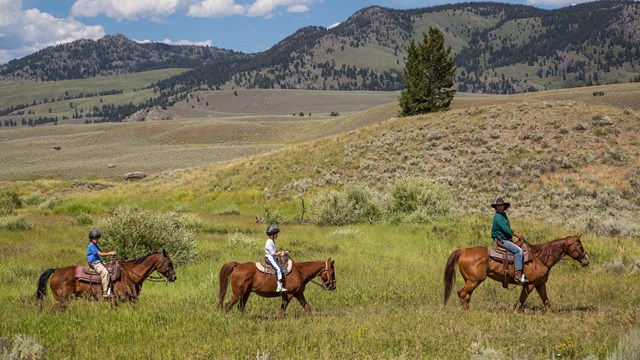
Coggins Test
All stock (horses, burros or mules) within Yellowstone must have a negative EIA or Coggins test within the last 12 months. 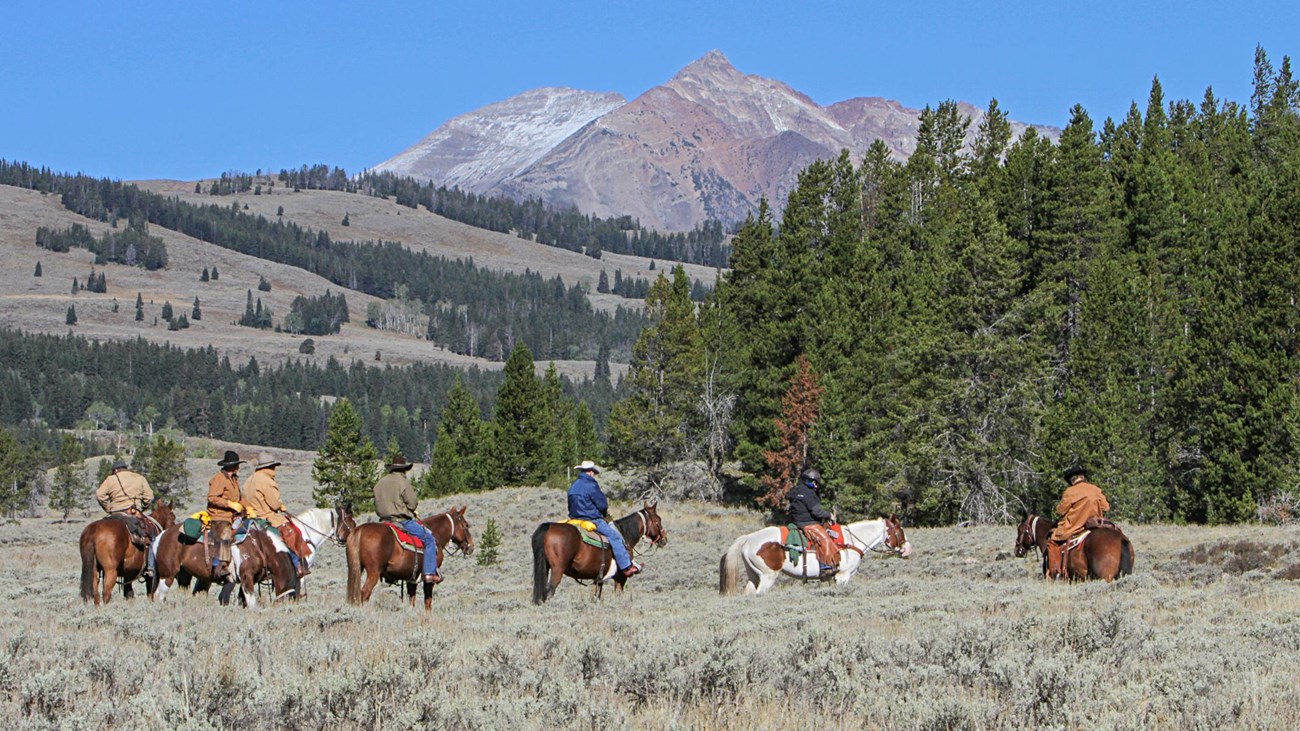
Ride a Horse
Bring your own stock or take a guided ride. |
Last updated: November 4, 2019
